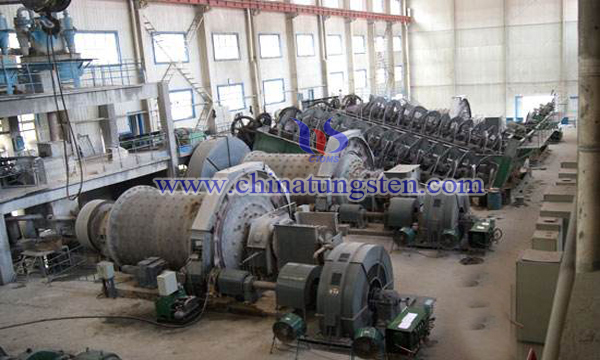A Preparation Process that Lowers the Production Cost of Tungsten Metallurgy
- Details
- Category: Tungsten Information
- Published on Wednesday, 01 August 2018 17:14
The alkali extraction method is the main method for smelting tungsten concentrate. Due to its strong adaptability to raw materials and high extraction rate, it has become the mainstream process for processing tungsten mineral raw materials. However, in the actual tungsten smelting process, a high tungsten leaching rate is required, and the consumption of NaOH is large. For example, when processing a wolframite concentrate, the NaOH consumption is 1.5 to 2 times the theoretical amount when 99% leaching rate is obtained. When the scheelite concentrate is treated, the NaOH consumption is even 3 to 4 times of the theoretical amount.

It is well known that NaOH is obtained by electrolysis of NaCl in the chlor-alkali industry. During the NaCl electrolysis process, the cathode chamber produces NaOH and H2, and the anode chamber produces Cl2. Due to the large demand for NaOH in the industry, and the relatively low market demand for H2 and Cl2, the price of NaOH has soared. In fact, the production costs of H2 and Cl2 are also directly or indirectly transferred to NaOH products. The price of NaOH is high, results in an increase in the cost of tungsten metallurgy.
In the past, due to the limitations of different processes, high cost. If tungsten metallurgy can be considered as a whole, it can be simplified and reduced. If the NaOH solution can be obtained by electrolyzing NaCl in the tungsten smelting workshop and directly used for leaching the tungsten mineral raw material, the NaOH does not have to go through the unreasonable high energy consumption. Cl2 can also be directly used for the oxidation treatment of ammonia-nitrogen wastewater, and the H2 produced can also be used for reduction and preparation of tungsten powder, so that the entire tungsten metallurgy process can achieve clean and efficient production. To this end, the research team of Central South University of China has innovated a comprehensive tungsten smelting process that considers energy conservation and emission reduction. The specific experiments include the following steps:
The NaCl solution with a mass concentration of 26% is electrolyzed to obtain a NaOH solution with a concentration of 29%, which is reacted at a theoretical consumption of 3.4 times with a scheelite having a grade of 68%. The solid-liquid ratio is 1:1, and the reaction temperature is controlled at 210 ° C, the leaching rate reached 98.3%, and a 215 g/L Na2WO4 solution is obtained, and a concentration of 246 g/L ammonium tungstate solution is obtained by ion exchange transformation. The generated chlorine gas is introduced into the ion exchange wastewater, and the ammonia nitrogen is oxidized to N2, and its concentration is lowered to 0.3 mg/L, and then the acid produced is neutralized and discharged. The chlorine gas is then bubbled into the ammonium tungstate solution, stirred for 60 minutes, and filtered to obtain tungstic acid. The concentration of tungsten in the filtrate was 2.8 g/L, and the ammonia nitrogen concentration was 2.3 mg/L. After the tungsten is absorbed by the macroporous weakly basic resin, and then neutralize the discharge. The obtained solid tungstic acid is calcined to obtain tungsten oxide, and the H2 produced by electrolysis is dried and then reduced to obtain a tungsten powder.
The advantage of this method is the combination of chlor-alkali industry and tungsten smelting process. Through the method of real-time preparation and use, the NaOH solution produced by chlor-alkali process, Cl2 and H2 can be directly used for tungsten mineral leaching and ammonia nitrogen wastewater treatment in tungsten smelting process. And reduction and preparation of tungsten powder, greatly reducing the cost of NaOH, reducing the cost of leaching of tungsten ore, and using by-product Cl2 for the thorough treatment of ammonia-nitrogen wastewater, achieving zero-emission of ammonia nitrogen at low cost, and no need to specialize The hydrogen system uses by-product H2 to reduce the cost of reducing tungsten powder. According to estimates, the production cost per ton of APT can be reduced by nearly 3,000 RMB.
- APT Manufacturer & Supplier, Chinatungsten Online: ammonium-paratungstate.com
- Tungsten News & Prices of China Tungsten Industry Association: www.ctia.com.cn
- Molybdenum News & Price: news.molybdenum.com.cn
- Tel.: 86 592 5129696; Fax: 86 592 5129797; Email: sales@chinatungsten.com



 sales@chinatungsten.com
sales@chinatungsten.com